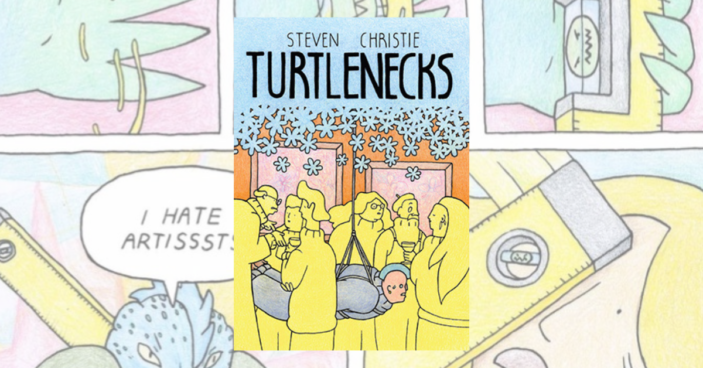
Steven Christie pays tribute to and pokes fun at the sometimes impenetrable, often critical, but unquestionably interesting world of art in his comedy graphic novel: Turtlenecks.
When art student Sam decides to donate his beloved flower necklace to a charity art auction, his friend Jules reminds him of the sentimental significance of the item. But the art auctioneers won’t let him take it back and the buyer, who happens to be the gallery owner showcasing Sam’s work, insists that Sam’s loss gives it even greater artistic value. Out of diplomatic options, Sam and Jules enlist the help of their fellow art students to stage an elaborate heist to retrieve the necklace, learning a thing or two about the value of art along the way.
Christie’s tongue-in-cheek approach is perfect for addressing the intricacies and hypocrisies of the art world. Ethical quandaries such as students being asked to donate their work to fund advertising for their art course sit alongside questions of artistic expression and what gives art value. Jules at one stage laments that galleries don’t allow space for people to appreciate individual works of art. They suggest that the ideal scenario is one where they “walk into an artist-run space and I can’t even see a single artwork. I don’t know who the artist is either – or the name of the gallery.” Jules says that in this scenario when they do find the piece it’s not for sale.
This particularly poignant scene raises questions that Christie explores throughout the rest of the story about what counts as art, how people interact with it, how commoditisation changes it, and how it changes depending on who is creating and consuming it.
Joining Sam and Jules on their heist are artist-turned-arts-lawyer Stacey, video artist Casper, and rich senior student Ryan. While the five don’t always agree or respect each other’s artistic abilities and styles, they quickly discover each person has something valuable to add to their operation. Bit by bit, they are forced to reconsider what makes an artist an artist.
The blurry boundaries of who can create art are further tested in the form of Dalziel, the gallery technician who despises artists. Dalziel’s role in the presentation and construction of art would technically make him one of the people he so dislikes, but he resists the label vehemently, and those around him seem happy not to acknowledge the extent of his contributions.
There’s a lot to like about this brightly coloured story with its healthy dose of sarcasm and a hilarious cast of pompous critics and jaded students. The art style is charming, and the artistic commentary is clever. And, as serious as the concepts Christie explores are, the tone remains light-hearted. Despite it all, it’s clear that he finds the art world endearing in its own way. Turtlenecks is an easy, fun read that’s sure to appeal to those who don’t quite ‘get’ modern art just as much as those who do.
![]()
![]()
![]()
![]()
![]()
FIVE STARS (OUT OF FIVE)
Steven Christie’s Turtlenecks is out now, published by AdHouse Books.
